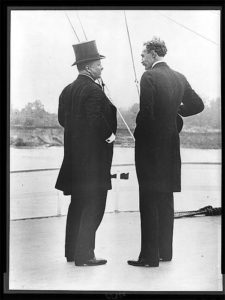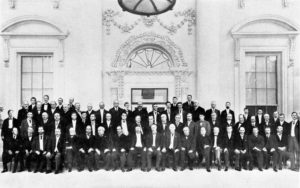The beginning of the first U.S. environmental movement is often pegged to the 1908 Conference of Governors, which occurred during May 13-15. The conference was the first meeting that called together the nation’s leaders to address the topic of conservation.
Teddy Roosevelt was president during this time, his terms running from 1901 to 1909. He was an ardent conservationist, advised throughout his presidential term by another prominent conservationist—Gifford Pinchot. Pinchot was the nation’s first chief forester, but more than that, he was a close advisor to Roosevelt on all areas of public policy. Pinchot espoused a general principle that natural resources should be used sustainably, neither over-exploited nor under-exploited.

Pinchot, along with the leader of the Inland Waterways Commission, W. J. McGee, convinced Roosevelt that he should call the nation’s leaders together to confront what they all saw as the despoliation of America’s natural resources. Accordingly, with McGee serving as the chief organizer of the event, Roosevelt invited hundreds of individuals to come to Washington for the conference.
Although themed as the governors’ conference, the attendees went far beyond state and territorial governors and their representatives. Anyone who was anyone came. The entire cabinet, all justices of the Supreme Court, senators and congresspersons, leaders of virtually all major business and philanthropic organizations (not just environmental groups, of which there were few), and representatives of federal and state agencies attended.
The attendees met for three days, with speeches and presentations covering a wide range of geographic locations and types of resources. At the time, “natural resources” included agriculture, minerals and mining, water and forests—virtually everything that humans depended on from nature. Certain aspects that we now consider essential parts of natural resources, such as biodiversity, weren’t represented—but it was early times for conservation.
The premise of conservation at the time was two-fold. First, natural resources should not be over-used, so severely exploited that their productive capacity would be lost in the long run—soils should not be eroded, for example. Second, natural resources should not be wasted, allowed to lie unused when the nation required all resources to fuel its prosperity—forests, for example, should be harvested to take advantage of the wood, the trees not left standing until they died or allowed to decompose once they had fallen.
The intense attention to resource management was needed because the country had not been paying attention. As one senator stated, “Those who succeed us can well take care of themselves.” And one representative said conservationists were “google-eyed, bandy-legged dudes from the East and sad-eyed, absent-minded professor and bugologists.” At this time, however, soil erosion was rampant, wildlife species had been hunted to near extinction, and eastern forests had been virtually cleared.

The Governors’ Conference changed that laissez-faire attitude, perhaps by the sheer size and scope of the meeting. At the conclusion, on May 15, the group issued a “Declaration of the Conservation Conference.” Among its pronouncements were the following:
“We the Governors of the States and Territories of the United States of America, in Conference assembled, do hereby declare the conviction that the great prosperity of our country rests upon the abundant resources of the land chosen by our forefathers for their homes and where they laid the foundation of this great Nation.
We look upon these resources as a heritage to be made use of in establishing and promoting the comfort, prosperity, and happiness of the American People, but not to be wasted, deteriorated, or needlessly destroyed.
We declare our firm conviction that this conservation of our natural resources is a subject of transcendent importance, which should engage unremittingly the attention of the Nation, the States, and the People in earnest cooperation.
We declare the conviction that in the use of the natural resources our independent States are interdependent and bound together by ties of mutual benefits, responsibilities and duties.”
The nation—and the world—has never looked back from that day onward. The 20th Century saw the founding of most natural resource science disciplines, the creation or expansion of major federal conservation agencies, the parallel creation of state-level natural resource agencies, passage of laws to protect resources and the general growth of public awareness of and commitment to environmental sustainability. (Also of note is that this meeting of governors was the start of annual governors’ conferences on various topics that led to the formation of the National Governors Association.)
We often say that we can see farther because we stand on the shoulders of the giants who preceded us. Most of them were there in Washington in May, 1908.
References:
Conference of the Governors of the United States. 1909. Proceedings. Available at: https://babel.hathitrust.org/cgi/pt?id=nnc1.cu09109439;view=1up;seq=2. Accessed May 11, 2018.
Dorsey, Leroy G. 2016. Theodore Roosevelt, Conservation, and the 1908 Governors’ Conference. Texas A&M Press, College Station. Available at: https://www.questia.com/library/120093465/theodore-roosevelt-conservation-and-the-1908-governors. Accessed May 11, 2018.
Library of Congress. Today in History – May 13. Available at: https://www.loc.gov/item/today-in-history/may-13/. Accessed May 11, 2018.
PBS. Declaration of the Conservation Conference, May 15, 1908. Available at: http://www.pbs.org/weta/thewest/resources/archives/eight/conconf.htm. Accessed May 11, 2108.
